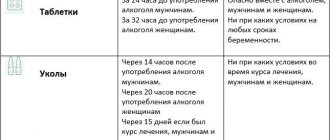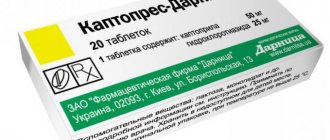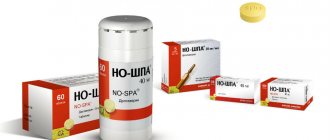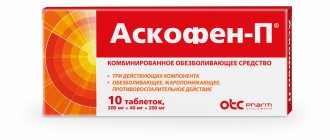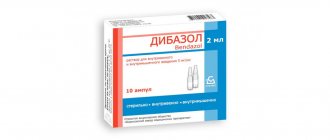Form of production
Papaverine is available in the form of tablets of 10 and 40 mg, rectal suppositories of 20 mg and a solution for injection of 20 mg in one ampoule.
The tablets have a white or yellowish tint. They are odorless, have a bitter taste, and have two perpendicular marks. For adults, the drug is available in a dosage of 40 mg, for children – 10 mg. Packed in blisters of 10 pieces. The cardboard package contains 2 blisters.
The suppositories are produced in a torpedo-shaped form for insertion into the rectum, have a white tint, and are odorless. Dosage – 20 mg. One blister contains 10 suppositories. The cardboard package includes one blister and an insert – Papaverine’s instructions.
Papaverine solution is transparent, odorless, available in ampoules of 20 mg. Cardboard packaging includes 10 ampoules.
Compound
The composition of Papaverine depends on the form of release of the drug. In all cases, the medicine contains one active component - papaverine hydrochloride. Tablets, injection solution and suppositories include various auxiliary components. The exact information can be found in the table.
Chemical composition of various forms of Papaverine
The pharmacological group of the drug is myotropic antispasmodics, vasodilators.
International nonproprietary name (INN) – Papaverine, Papaverine (English), Papaverinum (Latin).
Papaverine ointment
Papaverine ointment is a separate medication group. The product contains an active component - papaverine hydrochloride and auxiliary components - purified water, lanolin, sunflower oil.
Indications for use:
- conditions associated with intestinal spasms;
- spastic constipation;
- haemorrhoids;
- anal spasm;
- spasms caused by diseases of the genitourinary system.
Papaverine cream is applied to the perineum and anus to reduce pain. It is recommended to do this after carrying out hygiene procedures 2–3 times a day. If the patient uses other ointments and gels, be sure to inform the doctor about this.
pharmachologic effect
Papaverine hydrochloride is a myotropic antispasmodic agent. Reduces the tone and reduces the contractile activity of smooth muscles and therefore has a vasodilator and antispasmodic effect. Causes dilation of arteries, increases blood flow, incl. cerebral. When used in average therapeutic doses, papaverine hydrochloride has virtually no effect on the central nervous system. In large doses, it reduces the excitability of the heart muscle and slows down intracardiac conduction. It is an inhibitor of the phosphodiesterase enzyme and causes intracellular accumulation of cyclic 3,5-adenosine monophosphate, which leads to impaired contractility of smooth muscles and their relaxation during spastic conditions.
Pharmacological properties
The drug papaverine has a good antispasmodic and moderate analgesic effect. Due to its ability to relieve spasm from the smooth muscles of internal organs and blood vessels, the medicine has a mild hypotensive effect. This makes it possible to use it in the initial stages of hypertension and in some other conditions characterized by increased blood pressure.
Once in the body, the active component papaverine hydrochloride inhibits the activity of phosphodiesterase enzymes, which leads to a decrease in calcium concentration in cells. This process contributes to disruption of the contractile function of smooth muscles, consequently, muscle relaxation, elimination of spasm and pain.
The medicine Papaverine is used for diseases of the respiratory, digestive, cardiovascular systems, and for diseases of the kidneys, liver, gall bladder and other organs.
Important! Despite Papaverine’s ability to relax the smooth muscles of the muscles, a person’s motor activity is completely preserved.
Is it possible to insert papaverine for hemorrhoids?
Hemorrhoids are varicose veins of the rectum. Lumps that form on the veins make it difficult for stool to pass through, causing discomfort and even pain during bowel movements. Thanks to Papaverine, it is possible to achieve relaxation of the intestinal muscles, which greatly facilitates bowel movements. In the initial stages of hemorrhoids, Papaverine is an excellent remedy to prevent the problem from worsening. In addition, the drug is often prescribed for constipation, as suppositories have a laxative effect.
Pharmacokinetics
The active substance, entering the body, is quickly absorbed, regardless of the form of release of the drug. Communication with blood proteins is up to 90%. The drug is metabolized in the liver. The approximate half-life of Papaverine ranges from half an hour to 120 minutes. Active and auxiliary components are excreted from the body by the kidneys in the form of metabolites.
The effect of the medicine is observed after 15 – 20 minutes
When to use the product
What is Papaverine used for? The medicine is used orally, rectally, intravenously or intramuscularly for various diseases that cause spasm of the smooth muscles of the body.
Indications for use of Papaverine are as follows:
- diseases of the abdominal organs (cholecystitis, spastic colitis, pancreatitis, etc.);
- as a complex treatment for relieving hypertensive crisis;
- violation of urine discharge from the kidneys;
- spasms of peripheral veins;
- conditions associated with contraction of cerebral vessels;
- to relieve angina attacks;
- respiratory dysfunction;
- narrowing of the renal arteries;
- narrowing of the urinary tract caused by spasm, causing urinary retention.
Papaverine should be taken strictly according to a doctor’s prescription, despite its wide spectrum of action and apparent safety. Improper use of the drug often provokes many side effects.
Is it possible to drink papaverine during menstruation?
Periodic female pain associated with menstruation occurs due to contractions of the uterine muscles. This is how the organ gets rid of the overgrown endometrium, which was lined throughout the entire cycle, awaiting the attachment of the fertilized egg. Due to the absence of a fertilized egg, at the beginning of the cycle the level of hormones in the body changes, which causes emptying of the uterine cavity. For better rejection, the organ contracts, which causes severe pain in women. Papaverine, acting on smooth muscles, relieves pain and dilates blood vessels, which facilitates the release of blood clots. Papaverine is taken during menstruation according to two different schemes:
- if menstruation is always painful, you are allowed to take 1 tablet three times a day during the first three days of the cycle.
- If menstruation is usually painless, with occasional cramps, there is no need to take the drug as a course, a single dose is enough to stop the attack. If necessary, the dose can be repeated, but not earlier than 4 hours after the first use.
To whom the product is prohibited
Instructions for use of Papaverine include absolute and relative contraindications to the use of the medicine.
Absolute:
- individual sensitivity of the patient to the active and auxiliary substances of the drug;
- heart diseases associated with its conduction (blockades);
- acute kidney pathologies, renal failure;
- liver pathologies;
- glaucoma;
- age of patients after 65 years, which is associated with an increased risk of developing hypertension);
- children's age: injections/tablets/suppositories – 6 months/14 years/18 years.
When prescribing a drug, its contraindications must be taken into account.
Relative:
- recent traumatic brain injury;
- chronic renal failure;
- anaphylactic shock;
- vascular collapse;
- dysfunction of the adrenal cortex.
Important! The decision on the advisability of prescribing a drug in the presence of relative contraindications is made by the leading specialist, assessing the balance of benefit and risk in a particular case.
Contraindications
The drug is not used in the following cases:
- in case of individual intolerance or hypersensitivity to the ingredients of the drug;
- disruption of the transmission of nerve impulses in the conduction system of the heart (atrioventricular block);
- severe liver failure;
- glaucoma;
- comatose states;
- depressed breathing;
- bronchial obstruction;
- low blood pressure.
Papaverine is not used in childhood until the child is one year old and in elderly people due to the risk of increased body temperature
The use of the drug is possible only under the supervision of an experienced specialist due to the following reasons:
- recent intracranial injuries;
- chronic pathological changes in the kidneys;
- lack of thyroid hormones (thyroid hormones) in the body;
- shock;
- an increase in the number of benign pancreatic cells;
- arrhythmia caused by disruption of electrical conductivity and regulation of heart rate;
- adrenal insufficiency.
In addition, the use of papaverine in combination with monoamine oxidase inhibitors is prohibited.
Side effects
Papaverine in tablets, injections and when using rectal suppositories can cause side effects. More often this is due to non-compliance with the dosage prescribed by the doctor or self-medication with the drug.
Undesirable consequences:
- pathological decrease in blood pressure;
- heart blocks;
- increased sweating;
- nausea;
- constipation;
- yellow tint to the dermis and eyeballs;
- irritability, drowsiness;
- fatigue, loss of ability to work;
- when using the drug intravenously, vein thrombosis is possible;
- blood composition disorder;
- allergic skin rashes.
If the described symptoms appear, you must immediately stop taking the medication and seek medical help. Treatment is usually carried out by normalizing blood pressure and removing excess drugs from the body.
Adverse reactions
The drug is well tolerated by patients, but in some cases, with increased individual sensitivity or exceeding the dose after the injection, side effects may develop:
- Dizziness;
- Constipation;
- Bloating;
- Lethargy, drowsiness;
- Decrease in blood pressure;
- Increased sweating;
- Liver dysfunction, increased activity of organ transminases.
After discontinuing the drug or reducing the dose, all negative reactions disappear.
Directions for use and doses
Let's look at how to take Papaverine. For children and adults, the dosage is selected individually depending on the characteristics of the course of the disease.
The dosage and regimen are selected exclusively by the doctor.
The dosage of tablets for an adult is usually 40 – 60 mg. Papaverine is prescribed to children in accordance with the characteristics of the disease, age and weight of the patient.
Suppositories are prescribed in 1 - 3 pieces (20 - 60 mg) for adult patients. Until the age of 14, the drug is used with extreme caution only if necessary.
Papaverine solution is administered intravenously very slowly, exclusively by a medical professional. The contents of one ampoule are diluted with 20 ml of sodium chloride. Intramuscular injections of Papaverine are prescribed to patients at 40–60 mg per day.
Dosage
The excellent bioavailability of the drug allows the use of intramuscular, subcutaneous or intravenous injections without loss of its therapeutic abilities.
To avoid hematomas, a subcutaneous injection is given on the outer thighs or in the shoulder. An intramuscular injection is given in the outer upper quadrant of the buttock
Treatment with papaverine can continue for a long time, as prescribed by the attending physician, and is completed as the painful condition is eliminated.
Before administering a pharmaceutical drug intravenously, it is diluted with saline solution (NaCl) in an amount of 10–20 ml. To avoid discomfort in the patient, papaverine is administered slowly.
Intramuscular and intravenous injections involve the use of the following dosages:
- for the adult category of the population – one-time – 0.1 g, per day – 0.3 g;
- from six months to a year - one-time - 0.005 g, per day - 0.01 g;
- 2–3 years – one-time – 0.01 g, per day – 0.02 g;
- from 3 to 4 years – one-time – 0.015 g, per day – 0.03 g;
- from 5 to 6 years – one-time – 0.02 g, per day – 0.04 g;
- from 7 to 9 years – one-time – 0.03 g, per day – 0.06 g;
- from 10 to 14 years – one-time – 0.06 g, per day – 0.1–0.2 g.
It should be taken into account that the interval between intravenous injections should be at least 4 hours.
When administered subcutaneously, the dosage of the drug is usually 1 ampoule.
An overdose of the drug can lead to general malaise, diplopia, increased sweating, headaches and arrhythmia.
These symptoms can be eliminated with symptomatic therapy and gastric lavage.
Use during pregnancy
Despite the fact that one of the contraindications of Papaverine is the period of pregnancy and lactation, the drug is still prescribed to women bearing a child.
Many mothers face such a problem as increasing the tone of the uterus. This condition brings a lot of unpleasant sensations, in addition, it poses a threat of premature birth. To relax the muscles of the reproductive organ, Papaverine tablets or suppositories are often used. In a hospital setting, injections can be used.
Papaverine is used to prepare the cervix before childbirth. The drug is used in combination with No-Spa and other agents. Throughout the day, the woman is administered one suppository of each drug.
When breastfeeding, the use of Papaverine is contraindicated, since the active component of the drug passes into the mother's milk and therefore reaches the baby. If there is a need to use medication, stop feeding the baby.
Papaverine hydrochloride solution for injection 20 mg/ml in ampoules 2 ml No. 10
Name
Papaverine ghl solution dimin. 20 mgml in amp. 2 ml in pack No. 10
Description
Transparent liquid with a slight yellowish tint.
Compound
One ampoule (2 ml) contains: active substance - papaverine hydrochloride - 40 mg, excipients: DL-methionine, disodium edetate, water for injection.
Pharmacotherapeutic group
Drugs for the treatment of functional disorders of the gastrointestinal tract (GIT). Papaverine and its derivatives. ATX code – A03AD01.
Pharmacological properties
Pharmacodynamics Papaverine hydrochloride has a hypotensive and antispasmodic effect. The mechanism of action is associated with the ability of papaverine hydrochloride to block the activity of type IV phosphodiesterase. Blockade of the enzyme leads to the cessation of cAMP hydrolysis and an increase in its concentration in the smooth muscle cells of blood vessels and internal organs; cAMP limits the flow of calcium ions into the muscle cell and inactivates myosin light chain kinase, a contractile protein that ensures muscle contraction. Papaverine hydrochloride reduces the tone and relaxes the smooth muscles of internal organs (gastrointestinal tract, respiratory tract, genitourinary system) and blood vessels. Papaverine hydrochloride dilates mainly arterial vessels and increases blood flow, including cerebral one. Pharmacokinetics After subcutaneous and intramuscular administration, it is quickly and completely absorbed. Therapeutically effective concentrations of the drug in plasma are 0.2-2.0 mcg/ml. With repeated use of the drug, its pharmacokinetics do not change. Binds to plasma proteins by 90%. Easily passes through histohematic barriers. Forms a depot in the liver and adipose tissue. Subject to biotransformation in the liver. The half-life of papaverine hydrochloride (T?) is 0.5-2.0 hours. It is excreted in the form of metabolites in the urine, in small amounts (less than 0.5%) unchanged.
Indications for use
- prevention and relief of spasms of smooth muscles of internal organs during cholecystitis, spastic colitis, pyloric spasm;
- relief of biliary and renal colic;
- treatment of obliterating endarteritis, spasms of blood vessels in the brain and limbs (as part of complex therapy).
Contraindications
- children under 1 year of age;
- respiratory depression or coma;
- atriventricular (AV) block;
- hypersensitivity to papaverine or any of the excipients included in the drug;
- glaucoma;
- age over 75 years (risk of hyperthermia);
- heart failure, myocardial infarction (acute and recent), heart rhythm disturbances (bradycardia);
- intracranial hypertension;
- liver diseases.
Directions for use and doses
The drug is used subcutaneously, intramuscularly and intravenously. Adults and children over 14 years of age are administered subcutaneously and intramuscularly with 0.5-2 ml (10-40 mg) of a 20 mg/ml solution, and intravenously administered very slowly, at a rate of 3-5 ml/min, dissolving 1 ml 20 mg/ml solution of papaverine hydrochloride (20 mg) in 10-20 ml of 0.9% sodium chloride solution. The most effective is intravenous administration. For elderly patients, a single dose at the beginning of treatment should not exceed 10 mg (0.5 ml of a 20 mg/ml solution). Maximum doses for adults for subcutaneous or intramuscular administration: single - 100 mg (5 ml of 20 mg/ml solution), daily - 300 mg (15 ml of 20 mg/ml solution); for intravenous administration: single dose - 20 mg (1 ml of 20 mg/ml solution), daily - 120 mg (6 ml of 20 mg/ml solution). For children aged 1 to 14 years, the drug is used 2-3 times a day. A single dose is 0.7-1 mg/kg body weight. The maximum daily dose for children is (regardless of the route of administration): at the age of 1-2 years - 20 mg (1 ml of 20 mg/ml solution), 3-4 years - 30 mg (1.5 ml of 20 mg/ml solution), 5-6 years - 40 mg (2 ml of 20 mg/ml solution), 7-9 years - 60 mg (3 ml of 20 mg/ml solution), 10 -14 years -100 mg (5 ml of 20 mg/ml solution).
Side effect
The frequency is classified depending on the occurrence of the case: very often (? 1/10), often (
Pregnancy and lactation
During pregnancy and breastfeeding, the drug is recommended to be used only if the expected benefit to the mother outweighs the potential risk to the fetus/child.
Use in pediatrics
The use of papaverine hydrochloride in children under 1 year of age is not recommended due to the high risk of developing hyperthermia. Intravenous administration of the drug in children under 15 years of age is not recommended.
Extra Caution
Caution should be exercised and only small doses of papaverine hydrochloride should be used in persons with traumatic brain injury, impaired liver and kidney function, hypothyroidism, and adrenal insufficiency, since the hypotensive effect of papaverine hydrochloride is enhanced in them. In persons with benign prostatic hyperplasia, high doses of papaverine hydrochloride can provoke the development of acute urinary retention. Rapid intravenous administration can lead to fatal arrhythmias and apnea. It is advisable to monitor ECG before and during parenteral treatment. Caution should be exercised if there is a history of cardiac conduction disorders or decompensated cardiovascular disease due to the risk of cardiac arrhythmias. Administration of papaverine hydrochloride should be discontinued if symptoms of liver toxicity occur. Papaverine hydrochloride should be prescribed with caution to patients with decreased gastrointestinal motility due to the greater susceptibility of these patients to impaired digestive function.
Impact on the ability to drive vehicles and operate machinery
When driving vehicles and operating machinery, caution must be exercised due to the possible development of side effects when taking papaverine hydrochloride, such as drowsiness and dizziness.
Interaction with other drugs
With simultaneous use of papaverine hydrochloride, it potentiates the effect of alcohol and weakens the hypotensive effect of methyldopa. In smokers, the metabolism of papaverine hydrochloride is accelerated, and its concentration in the blood plasma and pharmacological effects are reduced. Nicotine may reduce or completely eliminate the vasodilating effect of papaverine hydrochloride. Phentolamine potentiates the effect of papaverine hydrochloride on the cavernous bodies of the penis when administered together. Diphenhydramine (diphenhydramine), metamizole (analgin) and diclofenac potentiate the antispasmodic effect of papaverine hydrochloride. Solutions of papaverine hydrochloride are pharmaceutically incompatible with glucose solutions (partial inactivation of papaverine hydrochloride). Papaverine hydrochloride may weaken the therapeutic effect of levodopa (antiparkinsonian drugs). Papaverine hydrochloride may enhance the effect of calcium channel blockers. When used together with antiarrhythmic and antihypertensive drugs, the hypotensive effect may be enhanced. Papaverine hydrochloride may enhance the effect of drugs that depress the central nervous system and exhibit synergism in combination with morphine.
Overdose
Symptoms of intoxication appear when high doses are administered, especially against the background of liver and kidney pathology. Characterized by the appearance of diplopia, weakness, drowsiness, hypotension, cardiac arrhythmia and tachycardia. There is no specific antidote. Helpful measures include discontinuation of the drug, gastric lavage, administration of activated charcoal, and maintenance and symptomatic therapy aimed at eliminating the disorders that have arisen.
Package
2 ml in glass ampoules.
- 10 ampoules along with the package insert are placed in a cardboard box (No. 10);
- 10 ampoules together with a leaflet are placed in a cardboard pack with a cardboard insert for fixing the ampoules (No. 10);
- 10 ampoules in a polyvinyl chloride film insert; 1 insert together with the insert leaflet is placed in a cardboard pack (No. 10x1).
Storage conditions
In a place protected from light, at a temperature not exceeding 25? C. Keep out of the reach of children.
Best before date
3 years. Do not use the medicine after the expiration date indicated on the packaging.
Conditions for dispensing from pharmacies
On prescription.
special instructions
During therapy with the medication, you should avoid drinking alcohol. The active components of the product in combination with alcohol can cause a negative reaction.
Papaverine often has positive reviews, but despite this, the medicine should be used only as prescribed by a doctor.
The drug of any release form is used with extreme caution among patients with severe pathologies of the kidneys and liver.
Alcoholic beverages should be avoided during treatment with Papaverine.
When administered intravenously, the injection is given slowly and under the supervision of a doctor. Too rapid administration can cause heart rhythm disturbances and other negative consequences.
Among patients who have suffered skull injuries, the medicine is used only if necessary in a hospital setting.
Analogs
The drug has many analogues that have similar therapeutic effects and indications.
Papaverine analogues included in the electronic list of drugs (RLS) are as follows:
- Platyphylline with papaverine - has an antispasmodic, vasodilating effect. The drug is used for diseases of the abdominal organs, to eliminate spasms of cerebral vessels, for angina pectoris, endarteritis, bronchospasms and other pathologies;
- Papaverine bufus is an antispasmodic medication that causes dilation of large and small vessels, restoring blood flow. The medicine has a hypotensive, moderate analgesic effect;
- No-Shpa forte is a drug that is produced in the form of tablets and solution for injection. The product has a vasodilator, antispasmodic, and moderate analgesic effect;
- Spazmolysin suppositories - used to eliminate pain caused by spasms of smooth muscles in diseases of the respiratory, cardiovascular, and digestive systems;
- Spazmobrew tablets are a product based on hyoscine butylbromide, which has an antispasmodic effect. It is used to treat spasms of the gastrointestinal tract, to prevent nausea and vomiting in patients who have undergone surgery, to coordinate the birth process in women with renal colic and other conditions.
The description of the products is for informational purposes only; exact information should be clarified from the instructions for use of the medicine or from the attending physician.
Indications
The medicine can be used as an independent remedy or along with other medications and helps get rid of:
- spasms of smooth muscles (most often with spastic colitis, cholecystitis, pylorospasm);
- serious condition due to excessive increase in blood pressure;
- endarteritis and other spasms of peripheral vessels;
- acute pain syndrome in the kidneys due to impaired urine outflow due to impaired patency of the upper urinary tract;
- bronchospasms;
- angina pectoris;
- spasms of blood vessels in the brain;
- difficulty in urinating or its absence due to spasms in the urinary tract;
- hemorrhoids, large hemorrhoids (in this case it is advisable to resort to rectal suppositories);
- high temperature;
- impotence.
Often, relaxation of smooth muscles before urological or proctological operations, as well as manipulations in the abdominal cavity, is achieved using Papaverine injections
Patient reviews
Valery, Taganrog “Papaverine is always in our medicine cabinet. Of course, my wife and I don’t take pills constantly and uncontrollably, but in some cases they really do help, especially since we both suffer from periodic high blood pressure. The drug is good, it’s inexpensive, I’m satisfied with its effect.”
Natalya, Kazan “When the weather changes, I always suffer from headaches. This is due to vasospasm. The doctor recommended that I take a Papaverine tablet. The product helps well, after 15-20 minutes I feel relief.”
Victor, Ivanovo “Several years ago I was diagnosed with urolithiasis. I was in the hospital where they crushed stones for me. Now fine sand is still coming out little by little. In this case, the pain is quite severe. To alleviate the condition, the doctor prescribed me Papaverine. The drug does its job perfectly, the pain goes away within a quarter of an hour.”
Arterial pressure
The combination of dibazole with papaverine normalizes blood pressure and eliminates the unpleasant symptoms of its increase.
The combined use of two drugs has a better medicinal effect than each drug separately, due to the ability to enhance the therapeutic effect of each other
The dosage should be calculated by the doctor depending on the general condition of the patient, as well as his blood and pulse pressure. As a rule, Papaverine 2 ml and Dibazol 4 ml are used.
In case of critical condition of the patient, Analgin is added to the above drugs to enhance the analgesic effect.
At the moment, there is a combined dosage form of Papaverine and Dibazol - Papazol. This drug is available in tablets and has vasodilating and antispasmodic effects.
Today, the pharmaceutical industry offers numerous medications for high blood pressure. But Dibazol and Papaverine do not lose their popularity due to their relative safety, good effectiveness and rare occurrence of side effects.
The drugs are administered intramuscularly and:
- eliminate vascular spasms in the brain;
- dilate blood vessels;
- relieve pain associated with high blood pressure and normalize its levels;
- minimize the risk of hypertensive crisis.
A universal remedy for lowering blood pressure is triad containing:
- analgin (50% solution, 2 ml);
- papaverine (2% solution, 2 ml);
- diphenhydramine (1% solution, 1 ml).
Triad injections also have an antipyretic effect, but in any case their use must be approved by the attending physician.



